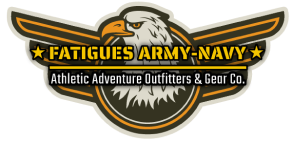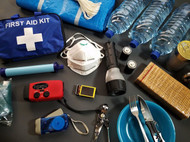30+ MORE Prepper Supplies (Part T
Posted by: Fatigues Army Navy Outdoor Gear on 29th Apr 2024
Previously, we published a list of essential supplies for preppers.
But any list could be better, so we decided to update with a second installment of prepper supplies.
Are you ready?
No Further Adieu: More Prepper Supplies
If your bug out bag (or home) doesn’t have the following, go out of your way to get some. These are also essential prepper supplies.
- A canner: Not a must have, but a canner and some jars will give you the ability to preserve food at home. Also, canners are large and can be used for boiling water, cooking, and more.
- Water treatment tablets or a lifestraw: We did previously argue in favor of having water stockpiled, but supplies can run out. You should also have iodine tablets or some other kind of water treatment to treat water you find, or a lifestraw. Water filters are also a must.
- Power banks: Your electronics won’t last long when the power goes out. All power banks are valuable, but those that are solar powered or can be hand-cranked are the best of all because they let you access power when other sources are unreliable.

- Chargers: You can’t charge your phone or computer or radio if you don’t have a charging cable, even if you do have power.
- A shemagh scarf: A shemagh scarf, also known as a keffiyeh, is one of those marvelous pieces of clothing that can be used in a million and one ways. We’ve written about this before in our blog, too. Check it out.
- Waterproof cases: Dry boxes were on our previous list, but not waterproof phone cases or dry bags, both of which can be lifesavers.
- Blankets: Always be prepared with some spare blankets. They can keep you warm but you can also use them to fashion pillows, sleeping pads, and so much more.
- Tin cups/canteens: Tin is better than plastic because you can use them as impromptu cooking vessels, or to boil water to render it safe to drink.
- Ferrocerium rods: Our previous list did have fire starting equipment, but not specifically ferrocerium rods. These are a must-have on any list of prepper supplies as a single ferro rod can be struck thousands of times, giving you the power to make a fire almost anywhere so long as you have tinder. Dryer lint is great for that, by the way.

- Seeds: Why seeds? Because if you really need to go off grid and grow your own food, you’ll need them. Get heirloom varieties only. With an heirloom plant, you can keep your seeds and grow new crops year after year; hybrids will not produce a viable crop from their offspring.
- Buckets: Buckets have a thousand and one uses we won’t go into here, ranging from collecting food to serving as a makeshift latrine.
- Super glue: Super glue is also really useful and can be used to glue holes in fabric and even seal wounds in a pinch. Very useful, all around.
- Plastic bags: Plastic bags can be used for food storage, for foraging, and for so much more.

- Paper and writing utensils: If it’s worth remembering, it’s worth writing down. If you can, get a pad that is waterproof and works in the rain, as well as a pen that will double as a kubotan.
- Cards and games: When stocking up on prepper supplies, it can be too easy to overlook the value of entertainment. Cards and board games may be able to help. Books are good too, but they are also expensive and heavy.
- WD-40: WD-40 is another one of those magic items that can be used for a million and different jobs, from lubrication to water displacement, to freeing stuck hardware.
- Glassbreakers or pry tools: Glassbreakers and pry tools are useful in a pinch if you lack a fully-stocked toolbox, which you should also have and which made an appearance on prepper supply list number one.
- Cash: How could we forget cash? You may need it when SHTF.

- Sharpening stone: We remembered knives and tools on the first list, but not a sharpening stone, which you will need to keep your tools sharp.
- Picture wire: Picture wire, like duct tape, is marvelously utilitarian. You can use it to form hooks, fix broken joints and hinges, and even to make snares.
- Ponchos: Staying dry in wet weather is not easy and getting wet and cold can compromise your immune system. Stock some ponchos for emergencies.
- Old-school tea-light heaters: There are special inverted metal pots you can buy online that, when you burn a tea light under them, can heat a whole room. They’re pretty cool and definitely worth looking into.
- Latex gloves: These are good for any situation in which you might have to handle something that you might consider a biological risk or an infection risk.
- Maps of your area: You never know when you might need them.
- Important documents: This includes IDs, birth certificates, and anything else you might need from a legal perspective.
- Magnifying glass: Not only can a magnifying glass help you get a better look at splinters and things like that, but you can also use them to help you start a fire, giving them a whole lot of uses.
- Olive oil or vegetable oil: Oil is great for cooking, which is an important use here, but it is also a solid impromptu lubricant. You can also use oil on the skin to treat dryness (if you don’t have vaseline). Cooking oils can also be used as a source of light and heat if you don’t have candles.

- Canned food: Food was on our last list, but besides dry food, canned food will last practically forever, making it an essential prepper supply.
- Whistles: They’re useful for signaling, make sure you have a few whistles.
- Mirrors: Same here. Mirrors are also useful for signaling and can also be used to check out your back if you’ve been injured and don’t have a buddy to help.
- Mineral oil: Mineral oil, like cooking oil, is a great lubricant and can also prevent rust on exposed hardware. It can also double as a fuel source or as a lamp fuel for light and heat.
- Face masks: Face masks, like N95 masks, will protect you from many airborne pathogens and chemical threats. They should be in your bug out bag and are therefore vital prepper supplies.
Get These and Other Prepper Supplies Here
Armed with the information in this and our other list of prepper supplies, you now have 60+ essentials that you need in your home’s kit or bug out bag.
Get to it, and plug up any holes where you find them so you can be better prepared.

